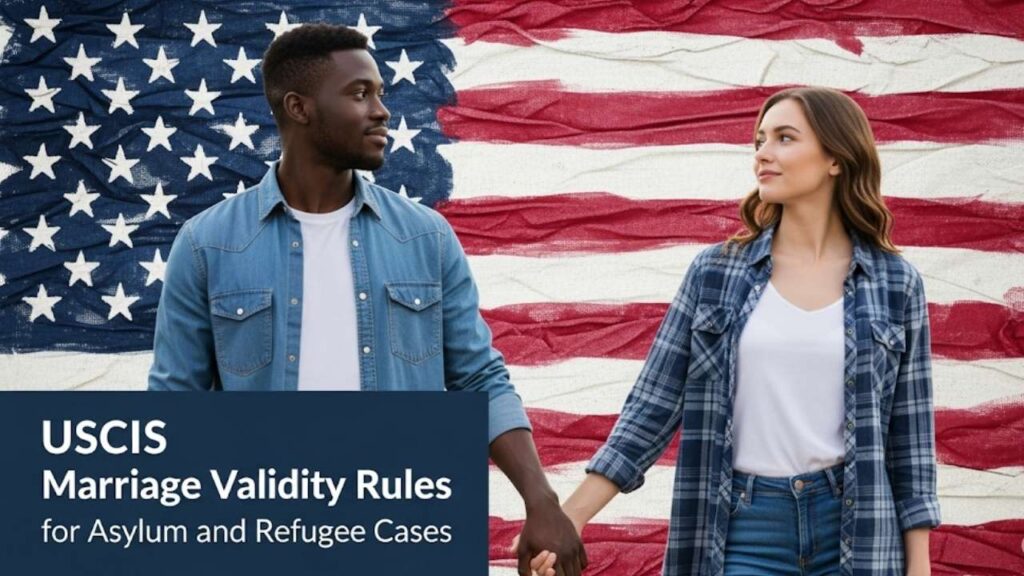Life as a refugee or asylee often involves heartbreaking separation from loved ones. The journey to reunite with a spouse in the United States is a path paved with hope, but also complex legal requirements. Recently, U.S. Citizenship and Immigration Services (USCIS) has updated its policy on how it determines a valid marriage for the purpose of reuniting these families. Understanding the updated USCIS Marriage Validity Rules for Asylum and Refugee Cases is now more critical than ever. This guide is here to walk you through the changes, clarify what they mean for you, and provide encouraging, actionable steps to help you successfully navigate the process and bring your family together.

In my years of advising clients on complex immigration matters, I’ve seen firsthand how policy shifts can create uncertainty. However, with clear information, you can approach your petition with confidence. This new rule emphasizes legal formalities, a significant change from previous, more flexible interpretations.
The Core Change: What You Need to Know
Effective March 3, 2025, USCIS has implemented a stricter, more uniform standard for recognizing marriages for refugee and asylee relative petitions. This update, detailed in the USCIS Policy Manual, eliminates a prior exception that sometimes recognized informal or customary marriages.
The new guidance firmly establishes the “place-of-celebration” rule. In simple terms, for your marriage to be considered valid for U.S. immigration purposes, it must be legally recognized and registered in the country or jurisdiction where the marriage ceremony took place.
Key takeaway: If your marriage is not legally binding in the location it was performed, USCIS will not recognize it for a spousal petition, even if the relationship is genuine and long-standing.
Why Did USCIS Make This Change?
USCIS has stated that this policy update is intended to ensure consistency and integrity in the immigration system.5 By aligning its own rules with longstanding decisions from the Board of Immigration Appeals (BIA), the agency aims to create a uniform standard for all marriage-based adjudications. The change is also linked to Executive Orders 14148 and 14163, which call for stricter oversight of humanitarian immigration pathways.

Previously, USCIS might have recognized “camp marriages” or customary unions for refugees who fled persecution and could not access official marriage registration systems. That flexibility is now gone. The new policy prioritizes legal documentation over situational context.
Understanding “Follow-to-Join” Benefits and Form I-730
This policy update directly impacts individuals filing a Form I-730, Refugee/Asylee Relative Petition. This is the primary tool for a principal refugee or asylee in the U.S. to petition for their spouse and unmarried children under 21 to join them. These are known as follow-to-join benefits.
To successfully use the Form I-730 for a spouse, you must now prove two main things:
- You are a principal refugee or asylee.
- Your marriage to the beneficiary (your spouse) is legally valid according to the laws of the place it was celebrated.
The petition must generally be filed within two years of your admission to the U.S. as a refugee or your grant of asylum.
Actionable Steps for a Successful Petition
While this change may seem daunting, it provides a clear, if narrow, path forward. Here’s what you can do to ensure your petition is successful.
1. Verify the Legal Status of Your Marriage
The single most important step is to confirm that your marriage is legally registered and recognized by the government of the jurisdiction where it took place.
- Do you have a government-issued marriage certificate? This is the primary evidence USCIS will require.
- Was your marriage a customary or religious ceremony? If so, find out if that ceremony is considered a legally binding marriage by the local laws. In many countries, it is not, and separate civil registration is required.
If your marriage is not officially registered, you must take steps to formalize it. This may mean re-marrying in a civil ceremony that results in a government-recognized certificate.
2. Gather Your Documentation
Once you have confirmed your marriage is legally valid, assemble the necessary evidence. A strong petition leaves no room for doubt.
- Primary Evidence: A certified copy of your official marriage certificate.
- Proof of Relationship: While the legal document is key, it’s still wise to show your marriage is bona fide (genuine). Collect evidence like:
- Photographs together over time.
- Records of communication (letters, emails, chat logs).
- Evidence of shared finances or property, if any.
- Birth certificates of any children you have together.

3. What About Proxy Marriages?
A proxy marriage is one where one or both parties are not physically present at the ceremony. For general immigration purposes, USCIS does not recognize a proxy marriage unless it has been consummated (the couple has physically been together after the marriage). This rule continues to apply. If you had a proxy marriage, you must provide proof that you and your spouse have lived together since the ceremony.
4. Seek Experienced Legal Counsel
Navigating U.S. immigration law is complex, and the stakes are incredibly high. An experienced immigration attorney can be an invaluable partner. They can help you:
- Determine if your foreign marriage meets the “place-of-celebration” rule.
- Advise on the best way to legalize an informal marriage.
- Properly complete and file the Form I-730 with all necessary evidence.
- Respond to any Requests for Evidence (RFEs) from USCIS.
The new USCIS Marriage Validity Rules for Asylum and Refugee Cases represent a significant shift toward a more rigid, evidence-based standard. While this removes some previous avenues for consideration, it also provides a clear directive: a legally recognized marriage certificate is non-negotiable.
This journey requires diligence, patience, and preparation. By understanding the new requirements, verifying your marital status, and gathering robust documentation, you can build a strong case for family reunification. Remember, the goal of this process, and your ultimate desire, is to bring your family back together. With careful planning and a clear understanding of the rules, that goal remains within reach. Start organizing your documents today, and don’t hesitate to seek professional guidance to light the way.
Navigating US Immigration Enforcement: Understanding and Responding to Deportations
Navigating US Study Visas: Mastering Your Social Media Account Privacy Settings
FAQs
Q1:What if my marriage was never officially registered due to war or lack of government access?
Under the new rules effective March 3, 2025, this unfortunately no longer qualifies for an exception. USCIS requires the marriage to be legally valid in the place it was celebrated.8 You may need to take steps to formally and legally register your marriage now before filing a petition.
Q2: Does this new rule apply to petitions filed before March 3, 2025?
The USCIS guidance states that it applies to all requests that were pending or filed on or after March 3, 2025.9 If your case was pending on this date, it will be evaluated under this new, stricter standard.
Q3:Can I still use evidence of a long-term relationship if I don’t have a marriage certificate?
Evidence of a bona fide relationship (like photos, communication records, etc.) is important to prove the marriage is genuine, but it cannot replace the core requirement of a legally valid marriage certificate. The certificate is the foundational piece of evidence now required by USCIS for a refugee spouse petition.






